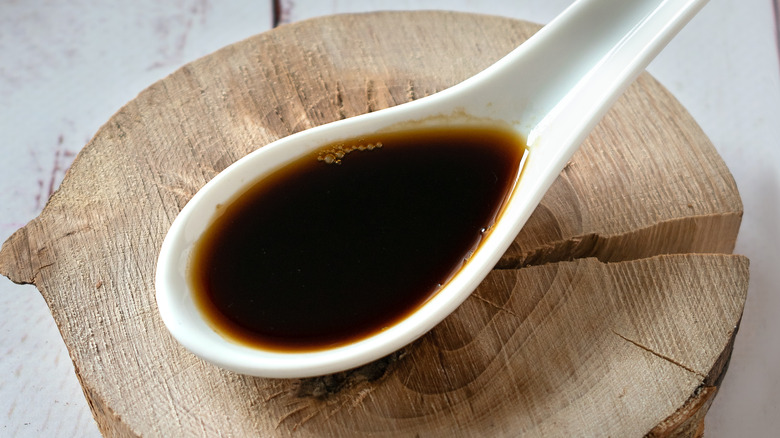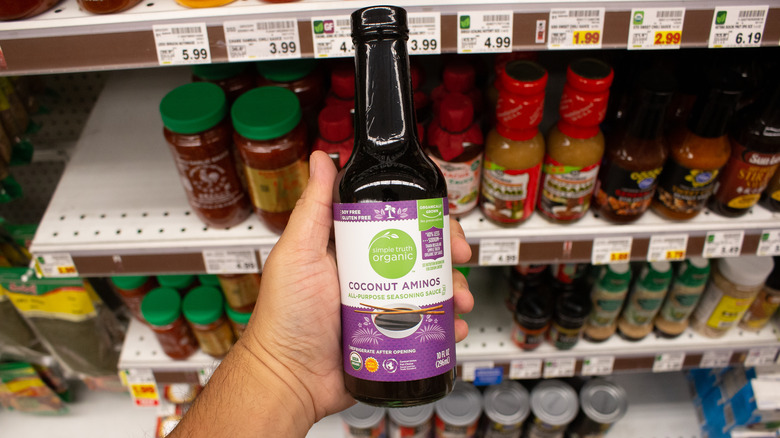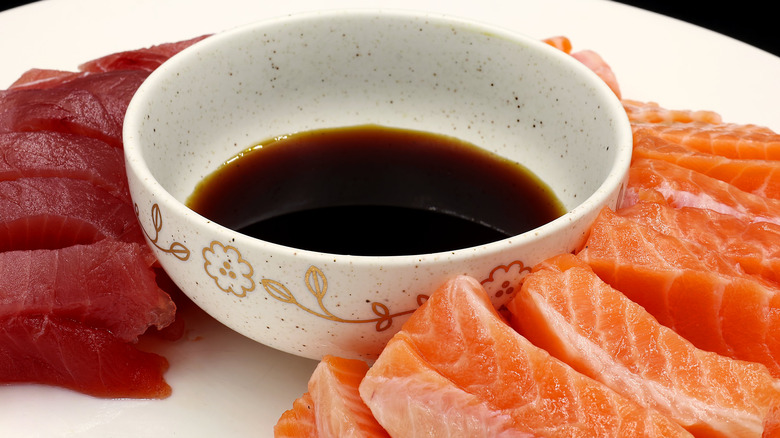Coconut Aminos Are The Soy Sauce Alternative We Need To Stop Sleeping On
Looking for a healthier alternative to soy sauce? If so, you might want to try coconut aminos. This savory sauce is low in sodium and minimally processed, with a rich umami flavor. Plus, it contains no gluten, soy, or other common allergens. Its unique aroma can complement fried rice, curries, stews, sushi, stir-fries, and just about any recipe that would otherwise call for soy sauce.
Coconut aminos are commonly used as part of the paleo diet, an eating pattern based on grass-fed meat, wild-caught fish, pastured eggs, veggies, and other whole foods. Their flavor is similar to that of light soy sauce but with a hint of sweetness. One teaspoon has roughly 40 calories and 66 milligrams of sodium, depending on the brand. By comparison, soy sauce delivers 4 calories and 335 milligrams of sodium per teaspoon and may contain gluten.
Both soy sauce and coconut aminos are healthier than mayo, queso, or ranch dressing. However, coconut aminos contain none of the chemicals found in some brands of soy sauce. They are also safer for those with high blood pressure, celiac disease, or food allergies.
What exactly are coconut aminos?
Coconut aminos are not particularly nutritious but contain about 20% less sodium than soy sauce, depending on the ingredients used. On top of that, they have significantly fewer ingredients and can fit into most diets. Traditionally, this condiment is produced by fermenting raw coconut sap with sea salt. Some manufacturers may also add coconut sugar, garlic, vinegar, and other natural ingredients. For example, Coconut Secret offers three types of coconut aminos made with organic coconut sap, salt, paprika powder, cayenne pepper, and other spices.
From a culinary perspective, this seasoning has a milder taste than soy sauce. Apart from that, their color and texture are similar. The flavor of coconut aminos can be described as salty, savory, and slightly sweet. This makes them suitable for meat and fish dishes, quinoa fried "rice", salads, vinaigrettes, and marinades. It's also worth mentioning that coconut aminos don't taste like coconut.
From a nutritional standpoint, coconut aminos contain trace amounts of vitamins, minerals, and phytonutrients. Coconut sap, the main ingredient, is rich in vitamin C, B-complex vitamins, magnesium, calcium, potassium, zinc, and antioxidants. However, you'd have to consume huge amounts of coconut aminos to reap the benefits.
How to use coconut aminos in your recipes
As mentioned earlier, coconut aminos can replace soy sauce in most recipes. If, say, you normally add soy sauce to ramen, swap it for coconut aminos to cut back on salt. You can also mix them with honey and red pepper flakes to make a glaze for roasted veggies, or drizzle them over cooked rice, quinoa, or savory oatmeal to jazz up the flavor. Another option is to combine them with rice vinegar, sesame oil, and chili paste, and then use this mixture as a dressing for coleslaw.
Craving BBQ sauce? Mix coconut aminos with garlic, honey, tomato paste, and spices. If you're in the mood for Asian food, dip your sushi rolls into a mixture of pickled ginger, wasabi, and coconut aminos. For a healthy snack, toss your favorite nuts with coconut aminos, raw honey, and cinnamon before roasting them in the oven. This condiment can also be a delicious addition to seafood dishes, egg rolls, noodles, and minestrone.
Note that coconut aminos are not the same as liquid aminos. The latter contains soy and undergoes more extensive processing. Additionally, it tends to be higher in sodium and tastes pretty much like soy sauce.


